Wing it! Or not ...
Wingless dry flies are simple to tie and catch fussy trout.
by Clive Schaupmeyer
Do mayfly dry flies require wings? The trout do not seem to think so and therefore I tie the majority of my mayfly dry flies without wings.
There are several reasons why I don't bother with wings:
- the flies are simple and therefore faster to tie
- my fingers look and act like fat 'smoky' sausages, and therefore holding hackle tips is hard,
- and, from my experience, the benefit of wings is questionable most of the time.
I know - I know! The hackle-tip wings represent wings of the natural mayflies and are supposed to be an important feature of imitative dry flies. Perhaps there are times when this is true. But, trout can be fooled most of the time
with flies that do not have hackle-tip wings.
In my humble opinion, fly presentation along with fly size, body color, and body taper are more important than wings. In other words, well presented wingless dry flies in the right size, shape and color will catch trout most of the
time on most waters. (Don't get me wrong here ... dry flies tied with wings are very pretty and I admire folks that tie them with great care and artistry. I just like my mayfly dry flies simple (wingless.)
Fly body color is no doubt more important in daytime than in low light and we must pay attention when on the stream. If you are new to fly tying and fly-fishing (and trying to match your dry flies to the natural insects) have a clo
se look at the bellies of the naturals on the water. Undersides are often lighter than the upper body. So it is important to tie wingless (or winged) dry flies with the right body color, or at least right shade of color - 'color-value' as artists will tel
l you. Commercial fly patterns (like Blue-winged Olives) are sometimes too dark to match naturals. This is often aggravated when the body material is treated with fly floatant - turns darker yet. So pay close attention to color and shade (or value) of col
or when the fly is wet.
In addition to fly color, tapered body and overall fly shape is also important. I don't know how much of the fly body the trout can see, but it seems to me that it cannot hurt to copy the body shape of the naturals. Many commercial
flies are too 'stubby' and their bodies are shaped like hot dog wieners instead of tapered carrots. And Catskill dries are too thin in the thorax area where the naturals are the thickest. Perhaps body taper is not critical during the day, but it could be
during the evening when the trout might be able to see the body silhouette. (Although the effects of the bent water film 'meniscus' could mask the shape or distort shape anyway.) But I'm sticking with a shape that looks right to me.)
Following is the general process for tying generic wingless Blue-winged Olive dry flies. (The body color came out slightly over-exposed in the photos. It's the technique I was trying to capture.) This method differs from the tradit
ional Catskill style of tying in that the hackle is wrapped over the dubbed thorax - and the thorax is dubbed ahead to near the hook eye. In my mind, this technique results in flies that more closely imitate the leg-body-thorax relationships of naturals.<
p>
- Tie in the tail using your preferred method. Here the thread tag has been left attached to help split the tail fibers. After the fibers have been anchored, pull the tag forward, splitting the tail fibers in half (see last photograph), and anchor the t
ag with the tying thread.
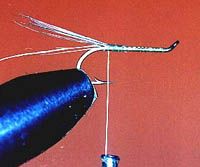
- Using whatever dubbing technique you prefer, wrap the dubbing forward to about half way of (what will be) the total body/thorax length. Form a definite forward taper in the body. At about half way, tie in the hackle - in this case a Hoffmann's medium
dun saddle hackle.
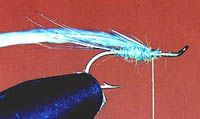
- Hold up the hackle and wrap the dubbing noodle behind the hackle base to make sure the uniform taper continues forward. Work the thread and dubbing noodle around the hackle.
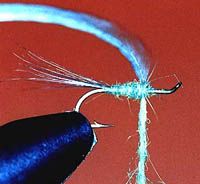
- Bring the dubbing forward to about an eye length from base of the eye. (In this photo the dubbing looks like it is crowding the eye, but that is mostly just loose dubbing fuzz.)
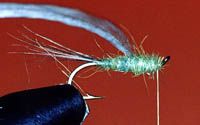
- Wrap the hackle forward about four or five times on top of the thorax dubbing and tie off. Whip finish.
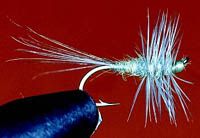
- The last photo shows the finished fly from the top with the somewhat split tails and body taper.
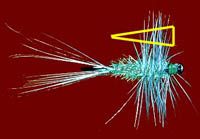
For mayfly bodies I prefer dubbing material, like HairTron,
because it contains sparkling Antron. If you use a dubbing material without sparkle
add some white or other colored Antron. Sparkle is good in any fly: nymph, streamer
or dry.
I tie this style of dry fly in various shades of grey,
yellow, tan/brown, and olive - usually in sizes from 14 to 18. Tails and hackles
vary from light or dark ginger, grizzly, or pale, medium or dark dun. Tied in the
right size and color, and presented well they will catch trout where you fish. Try
this method in the size and color of your favorite mayfly dry.
We can speculate forever what the trout actually see. It
seems to me that it cannot hurt to imitate the body color and body shape. As for
wings ... well I just don't know.
Send me your opinions about wings or add a
comment on the bulletin board.
Closing thought ... some folks are not hard of hearing; just
hard of listening. - CS
Return to Index
Copyright ©1998 Clive Schaupmeyer
Clive Schaupmeyer is an outdoor writer and photographer. He is the author of
The Essential Guide to Fly-Fishing,
a 288-page book for novice and intermediate fly anglers. His photo of a boy
fishing was judged the best outdoor picture of 1996 published by a member of
the Outdoor Writers of Canada. He fly-fishes for trout in Alberta's foothill
and mountain streams and for pike near his home in Brooks, Alberta.
Our Man In Canada Archives
|







